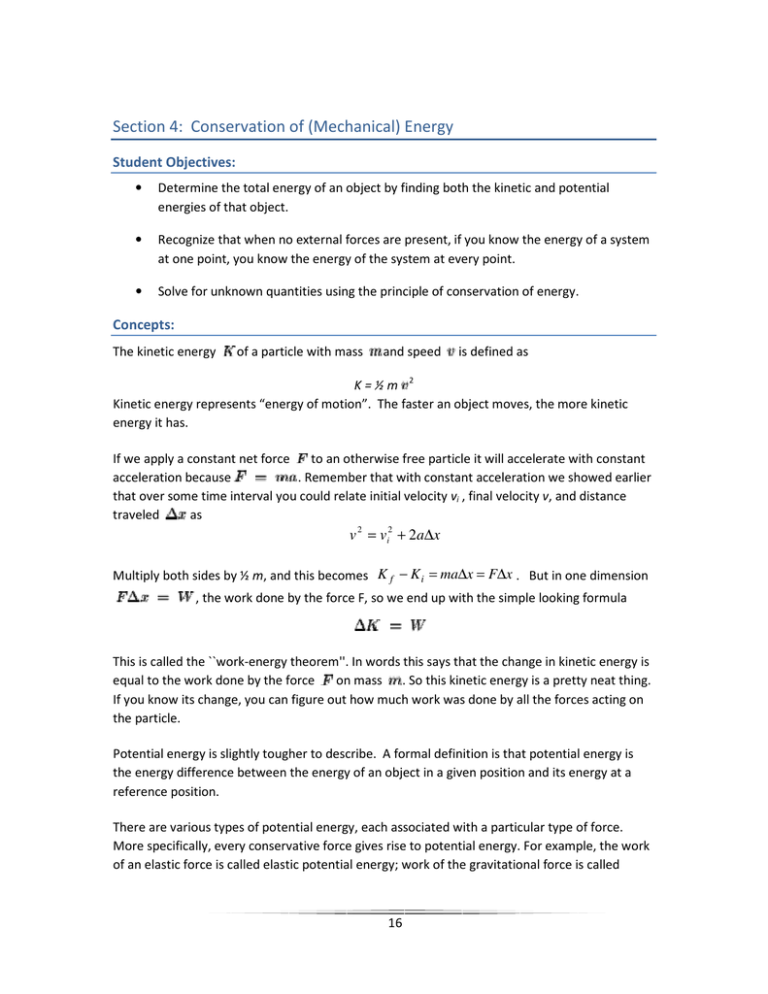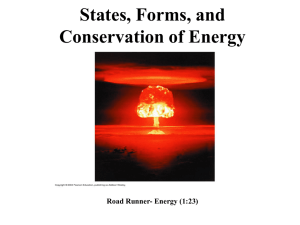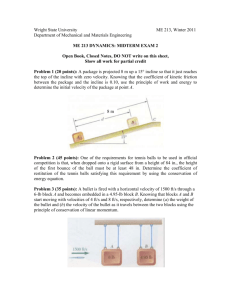Section 4: Conservation of (Mechanical) Energy
advertisement

Section 4: Conservation of (Mechanical) Energy Student Objectives: • Determine the total energy of an object by finding both the kinetic and potential energies of that object. • Recognize that when no external forces are present, if you know the energy of a system at one point, you know the energy of the system at every point. • Solve for unknown quantities using the principle of conservation of energy. Concepts: The kinetic energy of a particle with mass and speed is defined as K=½m 2 Kinetic energy represents “energy of motion”. The faster an object moves, the more kinetic energy it has. If we apply a constant net force to an otherwise free particle it will accelerate with constant acceleration because . Remember that with constant acceleration we showed earlier that over some time interval you could relate initial velocity vi , final velocity v, and distance traveled as v 2 = vi2 + 2a∆x Multiply both sides by ½ m, and this becomes K f − K i = ma∆x = F∆x . But in one dimension , the work done by the force F, so we end up with the simple looking formula This is called the ``work-energy theorem''. In words this says that the change in kinetic energy is equal to the work done by the force on mass . So this kinetic energy is a pretty neat thing. If you know its change, you can figure out how much work was done by all the forces acting on the particle. Potential energy is slightly tougher to describe. A formal definition is that potential energy is the energy difference between the energy of an object in a given position and its energy at a reference position. There are various types of potential energy, each associated with a particular type of force. More specifically, every conservative force gives rise to potential energy. For example, the work of an elastic force is called elastic potential energy; work of the gravitational force is called 16 gravitational potential energy. Let’s consider now specifically the case of gravitational potential energy. In this case, a simple expression for gravitational potential energy can be derived using the W = Fd equation for work, and the equation When accounting only for mass, gravity, and height above a reference point, the equation is: where U is the potential energy of the object relative to its being on the Earth's surface, m is the mass of the object, g is the acceleration due to gravity, and h is the height of the object above a reference point. The importance of the reference point is that, when the object is at that point, U = 0. For problems involving only conservative forces, we can now quite easily derive conservation of mechanical energy. We have ΔU = −W and Together this says that or We call K + U the total mechanical energy or, Δ . . We've just shown that = 0 or does not change in time = constant. Conservation of energy is more general than this however. If you have non-conservative forces such as friction, some mechanical energy goes into heat, which is mechanical motion at a molecular level. If you were to add in this extra energy, you'd see that energy is still conserved. The total energy is always conserved. That's a general principle of physics. 17 Worked Example: A 5 kg block slides, without friction, on a horizontal surface with a speed of v = 10 m/s. The block then proceeds to slide down an incline with a height of 2 meters into a pit.. The block then slides up another incline on the other side of the pit. Find, a) the speed of the block at the bottom of the pit. b) what maximum height does the block reach on the incline. 5 v = 10 m/s 2 m We can define our reference point at the bottom of the pit as where U = 0. Since we know both the height and the initial velocity of the block, we can find our total energy at that point as, E=K+U E = ½ mv2 + mgh Our initial velocity is 10 m/s and our initial height is 2 meters. The total energy then is, E = ½ (5 kg)(10 m/s)2 + (5 kg)(9.8 m/s2)(2 m) E = 348 Joules This is the total energy of the block at all points during its movement. a. At the bottom of the pit we have defined U = 0. Since we know the total energy of the block we can now write, E = 348 Joules = K + U But now we can consider the bottom of the pit where U = 0. 348 Joules = K 348 = ½ mv2 18 Be careful that this velocity is not the same as the initial velocity of the block, since we have dropped 2 meters in getting to the bottom of the pit, our potential energy has dropped and our kinetic energy will have increased to keep the total energy constant. Solving for the velocity now gives, v= 2(348J ) ≈ 11.8m/s . 5kg a) The maximum height of the block will be reached when it’s velocity, v = 0. We can see this by looking at our energy equation and noticing that as v decreases, h must increase to compensate. Thus, the maximum height of the block will be when not only v = 0, but K = 0 as well. At this point in the block’s movement we have, E = K + U = 348J E = U = 348J The only source of potential energy is the gravitational potential energy so, 348J = mgh h= 348J ≈ 7.1 meters. (5kg ) 9.8m/s 2 ( ) 19 Homework: 1. A ball is thrown upward with an initial velocity of 30 m/s. Using conservation of energy, find the maximum height of the ball. 2. A 10 kg block slides without friction at the top of an incline, when it reaches the bottom of the incline the speed of the mass is 12 m/s. Find the velocity of the block at the top of the incline. 20


